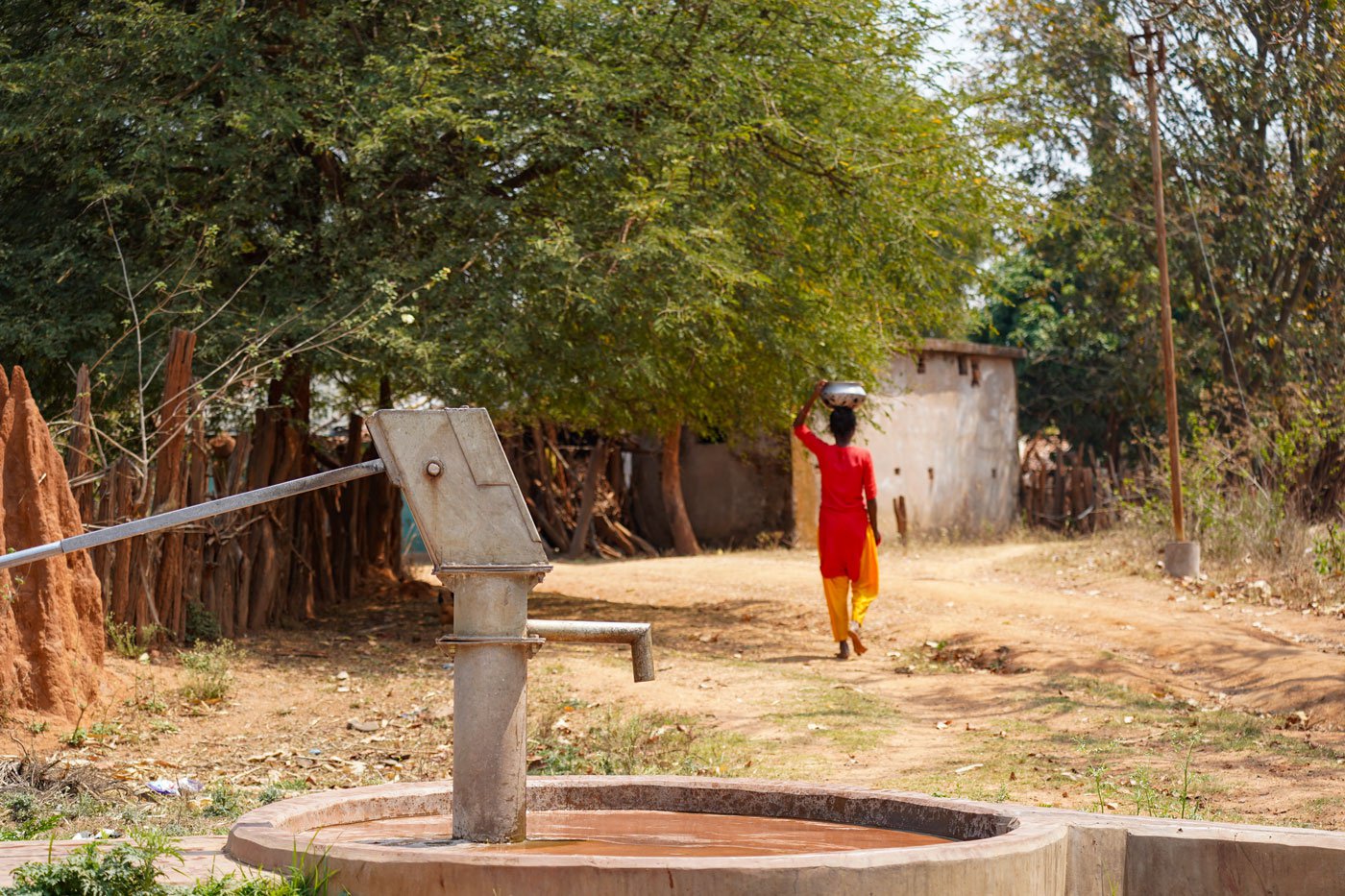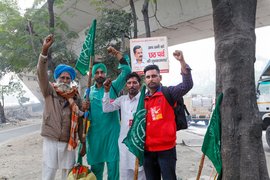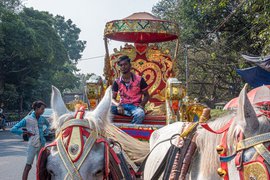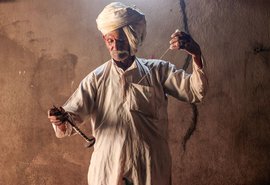“I regret getting married here.”
The 29-year-old Rozy is sharing her experience as a young bride. She’s not alone. Residents of the Dal Lake in Srinagar say girls don’t want to marry anyone living here. “We have already faced three rejections,” says Gulshan Nazir who has been looking for a match for her younger son. “Even matchmakers have stopped coming here now.”
The reason, says this mother from Baroo Mohalla, is the acute water shortage faced by residents who ironically live on one of the largest freshwater lakes in the state.
“Nine years ago, we would take our boats and collect water from different locations across Dal Lake,” says Mushtaq Ahmed, who works as a carpenter. “There were no water tankers.”
But for the last decade and more, Mushtaq, is on the main road at 9 a.m. sharp, waiting for state water tankers to arrive. His family of 10 living in Gudoo Mohalla depend on him. To ease things, he bought storage tanks and set up a pipeline, spending Rs. 20,000-25,000. “The set-up only works if there is electricity, which is a big issue in winters in Kashmir,” he says. This month (March) they had to carry water back in buckets due to a fault in the transformer.


Left: Hilal Ahmad, a water tanker driver at Baroo Mohalla, Dalgate says, 'people are facing lot of problems due to water shortage.' Right: Mushtaq Ahmad Gudoo checking plastic cans (left) which his family has kept for emergencies
In the village of Hijuli in Murshidabad district, residents also collect water from water tankers. However, their water is supplied by private players, charging Rs. 10 for 20 litres here in West Bengal.
“We have no other option, you see, this is the water we buy. If you miss it, you have nothing to drink,” says Lalbanu Bibi.
It’s clear that Rozy, Mushtaq and Lalbanu are among those who have not benefited from the Jal Jeevan Mission (JJM) of the union government. The JJM website says that 75 per cent of rural households (19 crore of them) have access to safe drinking water. It also says that the 2019 outlay of 3.5 lakh crore led to a tripling of taps in five years, so today 46 per cent of rural households have tap water connections.
Indeed taps were installed in Chinta Devi and Sushila Devi’s village in Akbarpur, Bihar, in 2017-18 under the Saat Nishchay plan of the Bihar state government. “The nal [tap] was installed six-seven years ago. A tank also. But till date not a single drop of water has come out from these taps,” says Chinta.
The reason is that Chinta and Sushila are Dalits, and the 40 Dalit households never got a water connection, while other higher caste homes did. The dry tap is now a marker of caste.


Left: Women wait to fill water in West Bengal. Here in Hijuli hamlet near Begunbari in Murshidabad district, Rajju on the tempo. Lalbanu Bibi (red blouse) and Roshnara Bibi (yellow blouse) are waiting with two neighbours. Right: In Bihar's Nalanda district, women wait with their utensils to get water from the only hand pump in the Dalit colony of Akbarpur panchayat


In the Dalit colony of Akbarpur, a tank was installed for tap water but locals say it has always run dry. Right: The tap was erected in front of a Musahar house in Bihar under the central Nal Jal Scheme, but water was never supplied
In the Dalit colony of Akbarpur where they live, there is only one hand pump which serves the largely Musahar and Chamar community (listed as Extremely Backward Caste and Scheduled Caste respectively, in the state).
When the handpump breaks down, which happens frequently, “we donate money among ourselves and get it repaired,” says 60-year-old Chinta, a resident of this colony in Nalanda district. The only other option is to ask the upper caste Yadavs, but they have been known to refuse, she says.
A study by the National Campaign on Dalit Human Rights (NCDHR) shows that in India, almost half (48.4 per cent) of all Dalit villages are denied access to water sources, and more than 20 per cent do not have access to safe drinking water.
Going by Raaku Nadage's experience in Palghar, Maharashtra, neither do Adivasis. In her village Gonde Kh. “Tankers never come,” Raaku, who belongs to the K Thakur community, says. So, when the local well serving 1,137 people dries up in summer, “we must walk through the jungle carrying two kalshis [pots to carry water] – one on the head and one in our arms. There are no roads.”
It takes up to three trips – walking roughly 30 kilometres over nine hours – for Raaku to fetch enough water for her family’s needs.
*****


Shivamurti Sathe (right) is an organic farmer from Kakramba and sells his produce daily in the Tuljapur market in Maharashtra. He has seen five droughts in the last six decades, and maintains that the water crisis is man-made
Kakramba village resident, Shivamurti Sathe has seen five droughts in the six decades of his life.
A farmer, he says that in the Tuljapur region of Maharashtra, once fertile lands have turned barren in the last two decades; not even a blade of grass grows. He blames the use of tractors for this: “With aut [plough] and oxen, the grass in the soil created wasan [natural bunds] that helped the water slow down and percolate. The tractors open up the soil and the water moves straight from one end to the other.”
He recalls being nine years old in 1972 when he witnessed the “first and the worst of all droughts. There was water, but there was simply no food. Things never returned to normal after that.” Sathe kaka sells vegetables and chikoos at the Sunday market in Tuljapur town. He lost an acre of his mango orchard to a drought in 2014. “We have overused the ground water and rendered our lands shallow by using all kinds of toxic chemicals.”
It’s March, and he says, “we are hoping to get some pre-monsoon showers in May or it is going to be very difficult this year.” Drinking water is a crisis. “We are paying 300 rupees for a thousand litres. And it is not only us humans, our cattle also need water.”
The shortage of fodder leading to the death of livestock makes it even more difficult for the cultivators to cope with the unpredictabilities posed by the next season, points out the first report of the Swaminathan Commission. “Drought in this way does not remain a temporary phenomenon, but one that is permanently crippling,” the report goes on to say.


Left: Droughts across rural Maharashtra forces many families into cattle camps in the summer. Right: Drought makes many in Osmanabad struggle for survival and also boosts a brisk trade that thrives on scarcity

An excerpt from a Kutchi song yet to be published on PARI speaks of the ordinary people’s distrust in the Government’s ability to find a solution to their water crisis. Perhaps, because of the colossal failure in water distribution even after the Sardar Sarovar project, where the height of the dam was raised on the dreams of parched farmers. The water in the region gets redirected systematically from drinking to manufacturing, from agriculture to industry, from poor to rich, leaving the farmers to struggle
In 2023 from June to September, Tuljapur block of Dharashiv (formerly Osmanabad) district received 570.3 mm of rain (against the normal 653 mm annual rainfall). More than half of it fell in just 16 days in July. The dry spells lasting 3-4 weeks in June, August and October, deprived the land of necessary moisture; water bodies did not get replenished.
So Kakramba’s farmers are struggling: “We are getting just 5-10 per cent of our need [now]. You will see a long line of pots and handa s all over the village,” he warns this PARI reporter.
“This [drought-like situation] is all man-made,” says Sathe kaka .
As is the crisis in Murshidabad district where groundwater is contaminated with arsenic. Lying on the banks of the Bhagirathi in the vast Gangetic plains in West Bengal, the once flush tubewells of sweet water are rapidly drying up.
People depended on tubewells as the Begunbari gram panchayat has no tap water (Census 2011). “We use tubewells, but all [went] dry now [2023],” says Roshanara Bibi. “As did water bodies here in Beldanga I block. Ponds too are depleting fast.” She says this is caused by lack of rains, along with the rampant unchecked use of shallow pumps drawing out the groundwater.
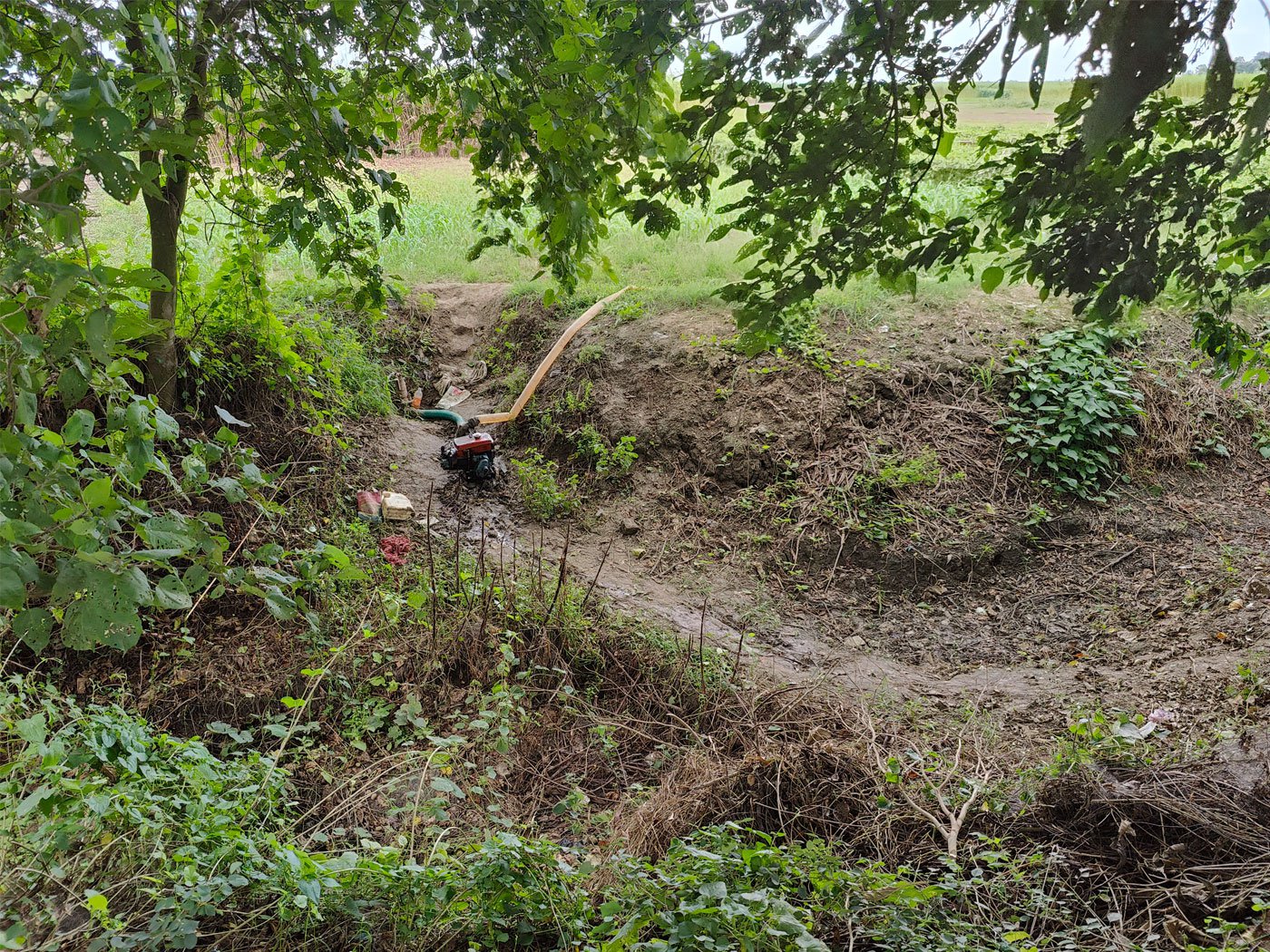
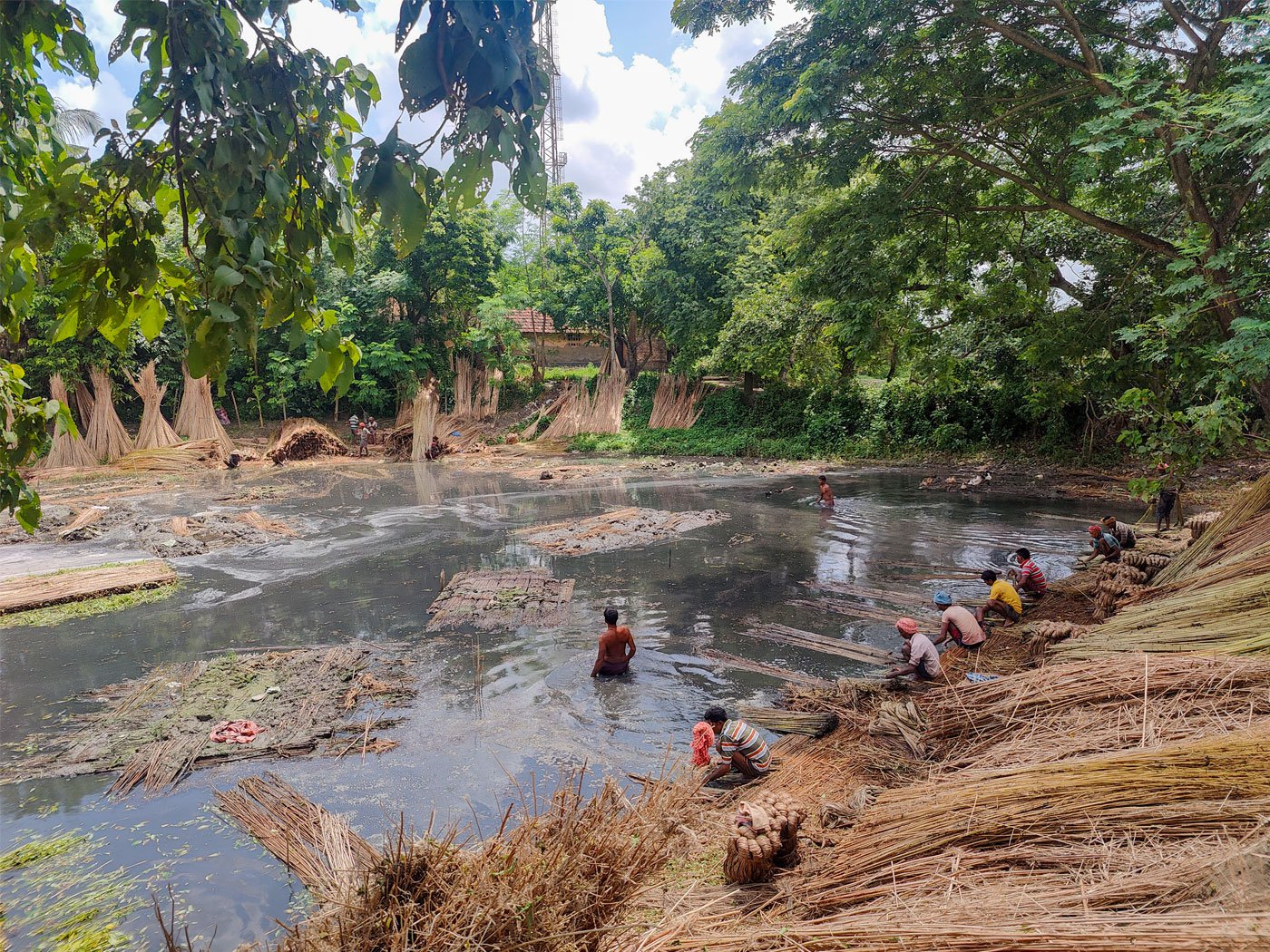
In Murshidabad, shallow pumps (left) are used to extract ground water for jute cultivation. Community tanks (right) are used for retting of jute, leaving it unusable for any household use
Groundwater is a major source for both agriculture and household use in India, contributing 85 per cent of rural water supply, says this 2017 report .
The overuse of groundwater here is a direct fallout of the rainfall deficit over successive monsoons, explains Jahanara Bibi. The 45-year-old resident of Hijuli hamlet is married into a family of jute cultivators. “The crop can only be harvested if there is enough water for the retting process which comes next. Once harvested, jute cannot wait, it will perish.” The mature standing jute crop in the fields across Beldanga I block at the end of August 2023, with no water, bears proof of a severe deficit in monsoon rains.
But in any case, tubewells are not to be trusted in these areas due to arsenic contamination, residents tell PARI. Murshidabad is one of the worst affected districts when it comes to arsenic in groundwater, impacting dermatological, neurological, and obstetric health.
With growing awareness of arsenic contamination, people are wary of tubewells. However, they are now completely dependent on private water dealers, and ironically no one knows if the water they are buying from the dealers is safe.
Water tankers bring some kids out of home, like Rajju, a Class 5 student of Begunbari High School. Rajju helps out by carrying water from the tanker to his home in Hijuli. Looking straight at this reporter he says with a wink, “this is better than studying at home.”
He is not the only happy carrier in these parts. A few kilometres from Hijuli, in Kazisaha, a few enthusiastic boys are helping elders refill their pots and jars, guided by the water dealer. The boys say they prefer this as “we get to loiter in the village sitting at the back of the van.”
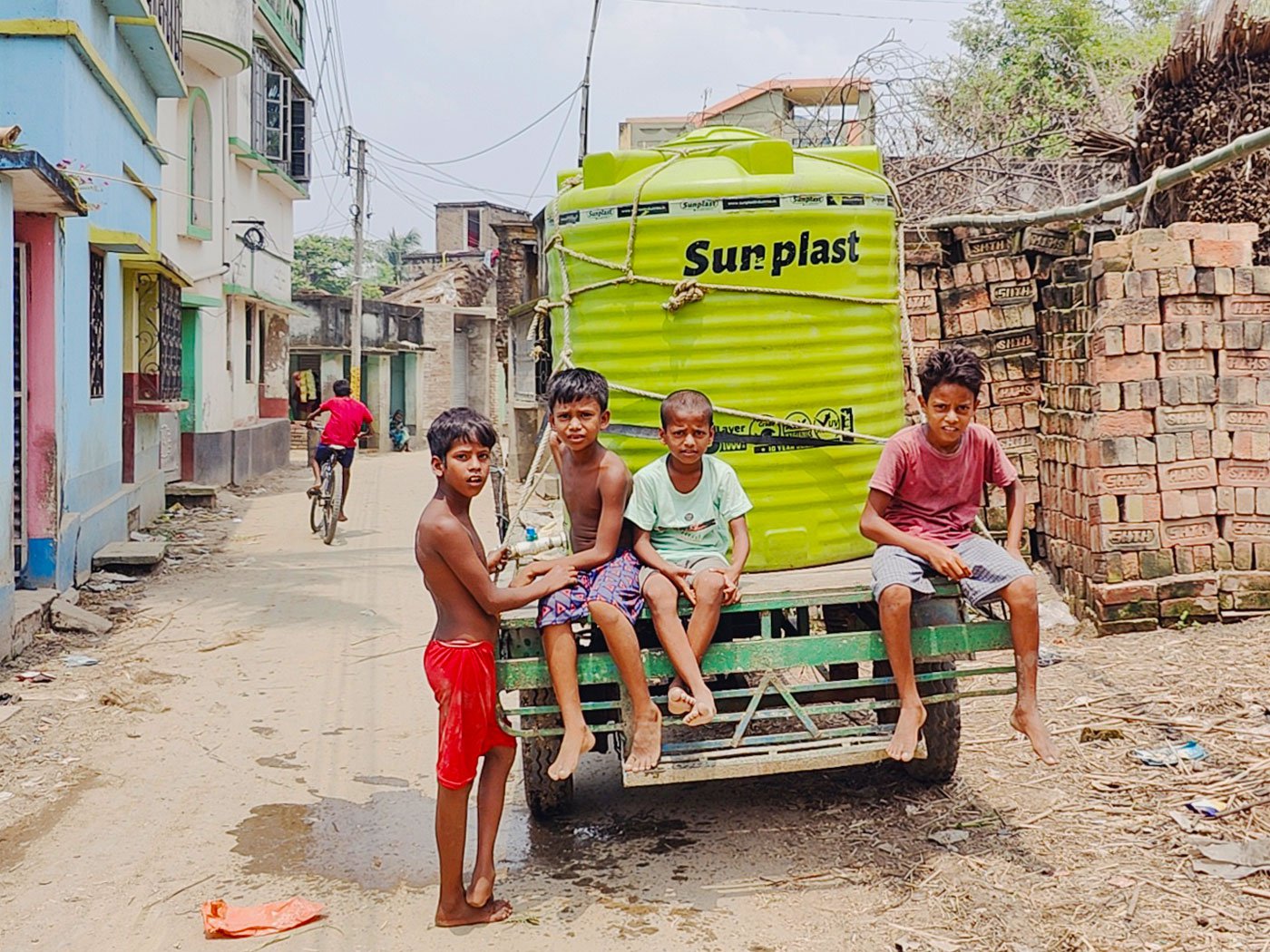

Left: In Hijuli and Kazisaha, residents buy water from private dealers. Children are often seen helping the elders and also hop on to the vans for a ride around the village. Right: Residents of Naya Kumdahin village in Dhamtari district of Chhattisgarh have to fetch water from a newly-dug pond nearby or their old village of Gattasilli from where they were displaced when the Dudhawa dam was built across the Mahanadi river

Shahubai Poman from Pokhar village of Purandar
taluka
tells us that even though grinding flour and pounding grain is a physically demanding chore, it is much easier compared to fetching water every day from long distances. Women in her village are truly fortunate, says Parvatibai Awari of Dev Torane village, Rajgurunagar, as they have a well with plentiful water and they all draw water from it. Filling up water for the family falls to the women’s lot, but fetching it from a well is much easier than walking long distances to reach a water source. The original Grindmill Songs Project team recorded these songs in Pune district in 1995 and 1999. The songs were composed even earlier, in times when water was replenished year after year and could be fetched from rivers and drawn from wells. Unlike today, when water and scarcity have almost become synonymous
Arsenic in Murshidabad and diarrhoea in Palghar, Maharashtra – thousands of kilometres apart but a fallout of the same problem – depleted water reserves.
Raaku Nadage says the water level in her village well is fast dipping and 227 households in Gonde Kh. rely on this one source. “This is the nearest and only source of water for us,” she says. Most people in this village in Mokhada taluka belong to the K Thakur tribe.
Two years ago, her son Deepak suffered from diarrhoea, most likely caused by the water. A 2018 sample study says that diarrhoea affects one in three children (33.4 per cent) in nine villages of Palghar district. Since her son’s illness, Raaku has taken to boiling water every day.
But before she can boil the water Raaku has to fetch it. In summer, when the water in the well dries up, the women make their way to the Wagh river – a distance of roughly nine kilometres. They repeat the three-hour journey two to three times a day, either early in the morning or after dusk when the temperatures are marginally better.
Across the Indian subcontinent, the burden of water-related household tasks falls unfairly on women – 71 per cent of women aged 15 years and above, are the ones to bring water home, (National Family Health Survey 2019-21 ).
“Men have to go [out] to work, so we have to bring water for cooking. In the morning, the hand pump gets very crowded,” says Chinta Devi. “In the afternoon, we need water for bathing and washing clothes etc. and then in the evening for cooking dinner,” she adds.


Left: In Gonde Kh village in Palghar district, a single well serves as the water-source for the entire community, most of whom belong to the K Thakur tribe. Right: When the well dries up in summer, the women have to walk to the Wagh river to fetch water two to three times a day


Left: Young girls help their mothers not only to fetch water, but also in other household tasks. Women and girls of the fishing community in Killabandar village, Palghar district, spend hours scraping the bottom of a well for drinking water, and resent that their region’s water is diverted to Mumbai city. Right: Gayatri Kumari, who lives in the Dalit colony of Akabarpur panchayat, carrying a water-filled tokna (pot) from the only hand pump in her colony. She says that she has to spend at least one to two hours daily fetching water
Close to 54 per cent of rural women – as well as some adolescent girls - spend an estimated 35 minutes getting water every day,” according to an UNICEF report . That is equivalent to an annual loss of 27 days’ wages.
The only source of water in this Dalit settlement is a champakal (handpump), and there are standing queues for water. “There is only one hand pump in such a big tola [settlement]. We stand carrying tokna-balti [utensils],” says Sushila Devi.
In summers when the handpump dries up, the women go to the fields to fetch water being pumped for irrigating crops. “It’s sometimes a kilometre away. A lot of time is wasted in fetching water,” says the 45-year-old Sushila Devi.
“ Garmi badhta hai to hum logon ko pyase marne ka naubat aa jata hai [In summer season when temperature increases, we are likely to die of thirst],” she adds angrily as she turns away to start preparing the evening meal.
This is a PARI multi location story, reported by Muzamil Bhat in Kashmir, Smita Khator in West Bengal, Umesh K Ray in Bihar, Medha Kale and Jyoti Shinoli in Maharashtra and Purusottam Thakur in Chhattisgarh. Songs are contributed from the ongoing projects on PARI Grindmill Songs Project and Songs of the Rann: Kutchi folk songs, curated by Namita Waikar and Pratishtha Pandya respectively. Sanviti Iyer created the graphics.
Cover Photo: Purusottam Thakur
